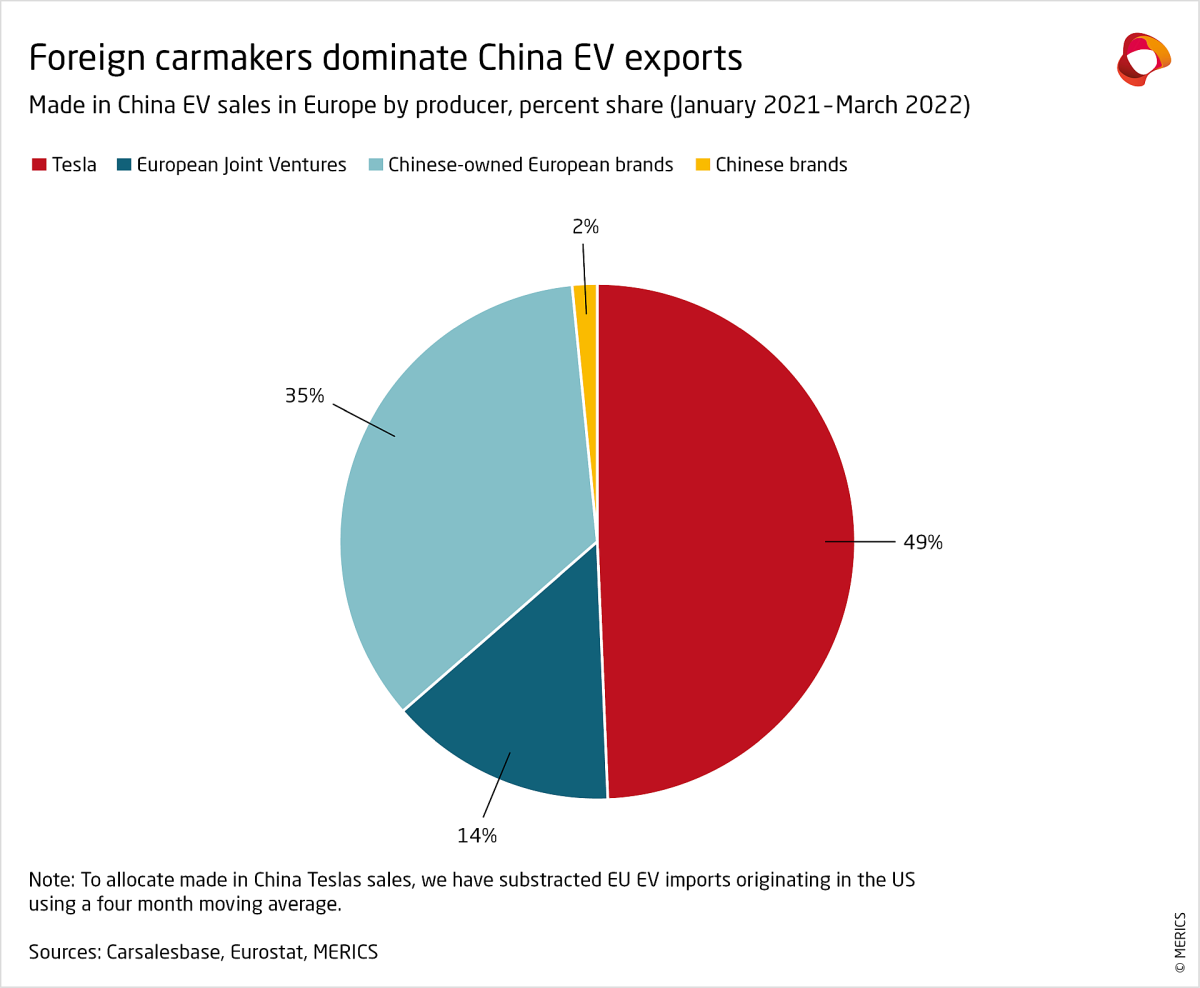China's EV Industry: Will America Fall Behind?

Table of Contents
China's Dominance in the EV Supply Chain
China's ascendancy in the electric vehicle sector is largely due to its robust and integrated supply chain. This dominance extends across multiple crucial areas, solidifying its position as a global EV powerhouse.
Battery Technology and Production
China holds a commanding lead in battery manufacturing, controlling a significant portion of the global supply of raw materials and boasting unparalleled cell production capacity.
- Key Chinese Battery Companies: CATL (Contemporary Amperex Technology Co. Limited), BYD (Build Your Dreams), and CALB (China Automotive Battery) are among the world's largest battery manufacturers, consistently innovating and scaling production.
- Government Subsidies: Generous government subsidies and tax incentives have fueled massive investments in battery research, development, and production, driving down costs and accelerating technological advancements.
- Advancements in Battery Technology: China is at the forefront of developing advanced battery technologies, including solid-state batteries and improved lithium-ion chemistries, promising longer ranges and faster charging times.
- Weaknesses: While China dominates, its reliance on imported lithium and cobalt raises concerns about supply chain vulnerabilities and geopolitical risks.
EV Component Manufacturing
Beyond batteries, China also excels in producing other vital EV components, further solidifying its control over the entire supply chain.
- Key Component Manufacturers: Numerous Chinese companies are major players in producing electric motors, power inverters, charging equipment, and other essential EV components.
- Global Reach: These manufacturers are not only supplying the domestic market but are also becoming increasingly significant suppliers to global automakers, including those in the American EV market.
- Implications for American Automakers: This dominance presents a significant challenge to American automakers, who face potential supply chain disruptions and increased costs if they rely heavily on Chinese components.
Government Policies and Incentives in China
China's strategic approach to the EV industry is underpinned by a comprehensive framework of government policies and incentives designed to foster rapid growth and technological leadership.
Subsidies and Tax Breaks
The Chinese government has implemented a substantial array of subsidies, tax breaks, and other financial incentives to promote EV adoption and manufacturing.
- Direct Subsidies: Purchasers of EVs often receive significant direct subsidies, reducing the upfront cost for consumers.
- Tax Incentives: Tax breaks for EV manufacturers and reduced import tariffs on EV components have encouraged investment and production.
- Infrastructure Development: Massive investments in charging infrastructure, including charging stations and battery swapping networks, are further driving EV adoption.
Investment in Research and Development (R&D)
China's commitment to the EV industry extends to substantial investments in research and development, fostering innovation and competitiveness.
- Government-Funded Projects: Significant government funding is channeled into research projects focusing on battery technology, motor efficiency, autonomous driving, and other crucial areas.
- Collaboration: The government actively encourages collaboration between universities, research institutions, and private companies to accelerate technological breakthroughs.
- Impact on Competitiveness: This sustained R&D investment enables China to stay at the cutting edge of EV technology, constantly improving performance, safety, and affordability.
Challenges Facing the American EV Market
Despite growing momentum, the American EV market faces several significant challenges that hinder its ability to compete effectively with China.
Supply Chain Dependence
The US currently relies on foreign suppliers, including China, for many crucial EV components, creating vulnerabilities in its supply chain.
- Component Shortages: The reliance on overseas suppliers exposes the US to potential component shortages, impacting production and delaying the rollout of new EV models.
- Geopolitical Risks: Geopolitical tensions and trade disputes can disrupt supply chains, leading to production delays and higher costs.
- National Security Concerns: Dependence on foreign suppliers also raises national security concerns, especially for critical components.
Infrastructure Development
The US lags behind China in developing a comprehensive and widespread EV charging infrastructure.
- Charging Station Density: The density of public charging stations in the US is significantly lower than in China, hindering EV adoption and increasing range anxiety among consumers.
- Government Initiatives: While the US government has implemented some initiatives to support charging infrastructure development, more substantial and coordinated efforts are needed.
- Private Sector Role: Private companies are playing a growing role in developing charging infrastructure, but government support and regulatory clarity are crucial to accelerate deployment.
Consumer Adoption Rates
While EV adoption is growing in the US, it remains lower than in China, partly due to various factors.
- Pricing: The higher initial cost of EVs compared to gasoline-powered vehicles remains a barrier to widespread adoption.
- Consumer Incentives: While the US offers some tax credits and incentives for EV purchases, they are often less generous than those offered in China.
- Public Awareness: Greater public awareness and education about the benefits of EVs are needed to encourage broader consumer acceptance.
Strategies for America to Compete
To regain competitiveness in the global EV market, the US needs to implement a comprehensive strategy that addresses the challenges outlined above.
Reshoring and Domestic Manufacturing
Bringing EV manufacturing back to the US is crucial to reduce reliance on foreign suppliers and enhance supply chain resilience.
- Incentives and Tax Breaks: The US government can offer tax breaks, subsidies, and other incentives to attract EV manufacturers to establish or expand domestic production facilities.
- Partnerships: Public-private partnerships can be leveraged to foster collaboration between government agencies, automakers, and component suppliers.
- Investment in Infrastructure: Investment in domestic infrastructure, including raw material processing and component manufacturing facilities, is essential.
Investing in Battery Technology and R&D
Increased investment in American battery technology and research is vital to regaining a competitive edge.
- Government Funding: The government should significantly increase funding for battery research and development, fostering innovation and breakthroughs.
- Private Sector Collaboration: Collaboration between government agencies, research institutions, and private companies is crucial to translate research into commercial products.
- Talent Development: Investing in training and education to develop a skilled workforce is essential for success in the EV sector.
Building a Robust Charging Infrastructure
Expanding charging infrastructure is paramount to address range anxiety and encourage greater EV adoption.
- Public-Private Partnerships: Public-private partnerships can help to accelerate the deployment of charging stations across the country.
- Standardization: Implementing standards for charging technology and infrastructure will improve interoperability and facilitate wider adoption.
- Smart Grid Integration: Integrating charging infrastructure with smart grids can optimize energy use and reduce strain on the power system.
Conclusion: The Future of Electric Vehicles – Can America Catch Up?
China's dominance in the EV industry is undeniable, driven by its integrated supply chain, government support, and substantial investment in R&D. The American EV market faces significant challenges, including supply chain dependence, inadequate infrastructure, and lower consumer adoption rates. However, America still has the potential to become a global leader in this crucial sector. By focusing on reshoring manufacturing, investing heavily in battery technology and R&D, and building a robust charging infrastructure, the US can effectively compete with China's EV industry. Understanding the dynamics of China's EV industry is crucial to shaping a competitive American EV market. The future of the American EV market depends on addressing the challenges posed by China's EV industry dominance, and taking decisive action now is crucial to avoiding falling further behind.

Featured Posts
-
 Will The U S Force Google To Split Its Advertising Business A Deep Dive
May 05, 2025
Will The U S Force Google To Split Its Advertising Business A Deep Dive
May 05, 2025 -
 Ufc 314 The Complete Fight Card And Bout Order
May 05, 2025
Ufc 314 The Complete Fight Card And Bout Order
May 05, 2025 -
 Actors Join Writers Strike Complete Hollywood Shutdown Looms
May 05, 2025
Actors Join Writers Strike Complete Hollywood Shutdown Looms
May 05, 2025 -
 Oskar 2024 I Entasi Metaksy Emma Stooyn Kai Margkaret Koyalei
May 05, 2025
Oskar 2024 I Entasi Metaksy Emma Stooyn Kai Margkaret Koyalei
May 05, 2025 -
 Blue Origin Scraps Rocket Launch Due To Vehicle Subsystem Problem
May 05, 2025
Blue Origin Scraps Rocket Launch Due To Vehicle Subsystem Problem
May 05, 2025
Latest Posts
-
 Emma Stones Daring Oscars 2025 Look Sequin Louis Vuitton And Pixie Cut
May 05, 2025
Emma Stones Daring Oscars 2025 Look Sequin Louis Vuitton And Pixie Cut
May 05, 2025 -
 Bollywood News Cruella Trailer Showcases Emma Stone And Emma Thompsons Conflict
May 05, 2025
Bollywood News Cruella Trailer Showcases Emma Stone And Emma Thompsons Conflict
May 05, 2025 -
 Disneys Cruella Trailer Reveals Epic Showdown Between Emma Stone And Emma Thompson
May 05, 2025
Disneys Cruella Trailer Reveals Epic Showdown Between Emma Stone And Emma Thompson
May 05, 2025 -
 Emma Stone And Emma Thompsons Intense Rivalry In New Disneys Cruella Trailer
May 05, 2025
Emma Stone And Emma Thompsons Intense Rivalry In New Disneys Cruella Trailer
May 05, 2025 -
 Emma Stooyn Kai To Eperxomeno Rimeik Toy Body Heat
May 05, 2025
Emma Stooyn Kai To Eperxomeno Rimeik Toy Body Heat
May 05, 2025
